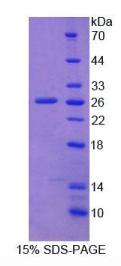
衰老关键蛋白2(FBLN2)重组蛋白
产品名称: 衰老关键蛋白2(FBLN2)重组蛋白
英文名称: Recombinant Fibulin 2 (FBLN2)
产品编号: YB152Ra011
产品价格: 0
产品产地: 中国/美国
品牌商标: 钰博生物/Ybscience
更新时间: 2023-08-17T10:29:50
使用范围: null
- 联系人 : 陈环环
- 地址 : 上海市沪闵路6088号龙之梦大厦8楼806室
- 邮编 : 200612
- 所在区域 : 上海
- 电话 : 183****2235 点击查看
- 传真 : 点击查看
- 邮箱 : shybio@126.com
- 二维码 : 点击查看
衰老关键蛋白2(FBLN2)重组蛋白
YB152Ra011
Recombinant Fibulin 2 (FBLN2)
Organism Species: Homo sapiens (Human)
Instruction manual
FOR IN VITRO USE AND RESEARCH USE ONLY
NOT FOR USE IN CLINICAL DIAGNOSTIC PROCEDURES
10th Edition (Revised in Jan, 2014)
衰老关键蛋白2(FBLN2)重组蛋白[ PROPERTIES ]
Residues: Ile858~Ser1069
Tags: N-terminal His-Tag
Accession: P98095
Host: E. coli
Subcellular Location: Secreted, extracellular space,
extracellular matrix.
Purity: >95%
Endotoxin Level: <1.0EU per 1μg
(determined by the LAL method).
衰老关键蛋白2(FBLN2)重组蛋白Formulation: Supplied as lyophilized form in 10mM
PBS, pH7.4, containing 1mM DTT, 5% trehalose,
0.01% sarcosyl and preservative.
Predicted isoelectric point: 5.6
Predicted Molecular Mass: 24.5kDa
Applications: SDS-PAGE; WB; ELISA; IP.
(May be suitable for use in other assays to be determined by the end user.)
[ USAGE ]
Reconstitute in sterile ddH2O.
[ STORAGE AND STABILITY ]
Storage: Avoid repeated freeze/thaw cycles.
Store at 2-8
oC for one month.
Aliquot and store at -80oC for 12 months.
Stability Test: The thermal stability is described by the loss rate of the target
衰老关键蛋白2(FBLN2)重组蛋白protein. The loss rate was determined by accelerated thermal degradation test,
that is, incubate the protein at 37oC for 48h, and no obvious degradation and
precipitation were observed. (Referring from China Biological Products Standard,
which was calculated by the Arrhenius equation.) The loss of this protein is less
than 5% within the expiration date under appropriate storage condition.
[ SEQUENCES ]
The sequence of the target protein is listed below.
INE CTSLSEPCRP GFSCINTVGS YTCQRNPLIC ARGYHASDDG TKCVDVNECE
TGVHRCGEGQ VCHNLPGSYR CDCKAGFQRD AFGRGCIDVN ECWASPGRLC
QHTCENTLGS YRCSCASGFL LAADGKRCED VNECEAQRCS QECANIYGSY
QCYCRQGYQL AEDGHTCTDI DECAQGAGIL CTFRCLNVPG SYQCACPEQG YTMTANGRS
[ REFERENCES ]
1. Zhang R.-Z., et al. (1994) Genomics 22:425-430.
2. Miosge N., et al. (1996) Histochem. J. 28:109-116.
3. Han G., et al. (2008) Proteomics 8:1346-1361.
4. Chen R., et al. (2009) J. Proteome Res. 8:651-661.
